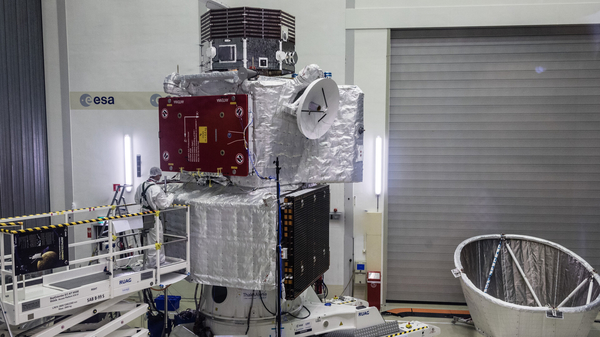How Do Gravity Assists Work?
A spacecraft can’t carry much fuel into space. If it needs to speed up or slow down, a planet can help.

A planet’s gravity and movement can help a spacecraft gain or lose speed.
©NASA/JPL/Space Science Institute
The Sun’s Relentless Pull
The Sun’s gravity pulls on everything in the solar system, including planets, comets, and spacecraft.
Why don’t the planets fall toward the Sun? They do, but they are in orbit around the Sun, which means they keep missing it. Objects in orbit are in an endless fall.
Comets orbit the Sun, too. Their orbital path is highly elliptical, which means it is a long, thin oval. At one end of the oval, the comet passes close around the Sun; at the other end, the comet is in the outer part of the solar system, beyond Neptune.
Traveling Through the Solar System
What happens to a spacecraft as it travels through the solar system?
If it travels away from the Sun, it moves against the Sun’s gravity and slows down. This is similar to a ball slowing down as it rolls uphill. The spacecraft could give itself a boost by firing its rocket. But a rocket can only carry so much fuel before it becomes too heavy to leave Earth.
On the other hand, a spacecraft speeds up if it travels toward the Sun, like a ball rolling downhill. In order to go into orbit around Mercury, the planet closest to the Sun, the spacecraft needs to slow down. It could do this by firing its rocket—but, again, there is a limit to how much fuel it can carry.
In a gravity assist maneuver, a spacecraft uses a planet’s gravity and movement around the Sun to help it speed up or slow down. How does this work? Let’s take specific examples from the Voyager 1 and BepiColombo missions.
How bright is the Sun on other planets?

An artist’s illustration of Voyager 1, which visited Jupiter, Saturn, and Saturn’s moon Titan. Its sister craft, Voyager 2, flew by Jupiter, Saturn, Uranus, and Neptune.
©NASA/JPL-Caltech
Voyager 1 at Jupiter
Voyager 1 was launched on September 5, 1977 by a Titan III-Centaur three-stage rocket. Over the next 18 months, the spacecraft traveled away from the Sun toward Jupiter, getting slower and slower.
On March 5, 1979 Voyager 1 swung by Jupiter. As the spacecraft approached, the pull of the planet’s gravity made it speed up. Later, as it headed off toward its next target, which was Saturn, Jupiter’s gravitational tug slowed the spacecraft down again.
Relative to Jupiter, the speed of Voyager 1 didn’t change. Relative to the Sun, however, it did.
In relation to Jupiter’s movement in its orbit around the Sun, the spacecraft passed behind the planet. It was therefore flung forward in the direction of Jupiter’s orbital movement, leaving the planet at a faster speed than it approached.
The energy for this slingshot came from Jupiter itself. While Voyager 1 gained speed from this maneuver—about 10 kilometers per second, or around 22,000 miles per hour—Jupiter lost a tiny fraction of its orbital speed around the Sun.

In addition to gravity assists, BepiColombo uses a solar-electric propulsion system to control its speed. Solar panels generate electricity, which charges atoms of xenon. An electric field shoots these charged particles (called ions) from the spacecraft, thrusting it forward or backward.
©ESA–C. Carreau
BepiColombo at Earth
BepiColombo blasted off on October 20, 2018 atop an Ariane 5 rocket, which has two stages plus boosters. The spacecraft will go into orbit around Mercury on December 5, 2025. As it nears the Sun, it travels faster. To help slow down, it uses a series of gravity assist maneuvers.
The first of these took place on April 10, 2020, and the gravity was provided by Earth. A year and a half after its launch, BepiColombo returned to its home planet for a flyby.
In this case, the spacecraft passed in front of the planet in its orbit. Earth’s gravity flung the spacecraft backward, against the direction of Earth’s orbit, and BepiColombo lost speed relative to the Sun.
Again, the energy for this braking maneuver came from the planet. BepiColombo lost about 5 kilometers per second (around 11,000 miles per hour), while Earth gained a tiny fraction of speed.
Over the course of its seven-year journey to Mercury, BepiColombo will make a total of nine speed-reducing planetary flybys: one at Earth, two at Venus, and six at Mercury itself.
Moons Can Also Be Used
Planets are not the only astronomical bodies that can provide gravity assists. The first of these maneuvers took place when the Luna 3 spacecraft made a slingshot around our own Moon in 1959.
The Cassini spacecraft used 162 flybys of Saturn’s moons to help it maneuver during its exploration of the Saturnian system between 2004 and 2017.